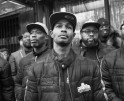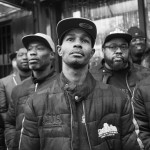Wesaam Al-Badry: Thunderhawk
Meeting with Wesaam Al-Badry at the 2017 PhotoAlliance Our World Portfolio Reviews was more than cathartic. I came away from our time together a little bit changed, impacted by his work, his personal story, and with the intuitive feeling that we would remain connected for a long time. I have so much admiration for Wesaam. He has a palatable desire to tell meaningful stories and his ability to understand the human condition allows for a profound sensitivity to his subjects and projects. The series I am featuring today is titled, Thunderhawk, and it is not just about the Standing Rock protest in North Dakota, but more specifically about Americans who live with the tremendous challenges of poverty and violence.
Wesaam has an upcoming exhibition, Our Sons, at SF Cameraworks , opening May 11th and running through July 1st, 2017. Our Sons is a documentary project about Bay Area mothers who have lost their sons to gun violence. Over the course of 2 years, Al-Badry photographed mothers, in their homes and with their son’s belongings, to create this intimate portrayal of the tragedy caused by gun violence in our communities.
Wesaam Al-Badry was born in 1984 in Nasiriyah, Iraq. When Al-Badry was seven years old, at the outset of what became known as the Gulf War, Al-Badry’s mother fled on foot with her five children, including his three-day-old sister, as artillery shells fell around them. After hiking all night, sometimes through knee-deep mud, they arrived at a refugee camp in Saudi Arabia.
In 1994, Al-Badry and his family were relocated to Lincoln, Nebraska after spending four-and-a-half years in a refugee camp. As a young man growing up in middle America, Al-Badry fiercely felt the disconnect between his experiences in Iraq and the refugee camps and his new American reality.
Bearing witness to the aftermath of the Iraq-Iran war that shaped the contemporary human condition into one of paranoia and distrust and his first-hand experiences living through Desert Storm and in refugee camps has sculpted Al-Badry’s work, which focuses on capturing the dispossessed, the alienated and ultimately, human dignity.
Al-Badry has worked for global media outlets, including CNN and Al-Jazeera America. His photographs have been featured in campaigns for the UNHCR, the ACLU, and other global organizations.
While his work focuses on photo reportage and documentary, Al-Badry also creates multimedia art that challenges and investigates social norms. Al-Badry currently resides in San Francisco, where he is pursuing a BFA in photography at the San Francisco Art Institute.
Thunderhawk
The meaning of these photographs has transformed in a matter of days. What once was a journalistic account of the Standing Rock water protectors now serves as a relic of history and record of a place and a people that have been burned to the ground once again. Fire defeated water in this game of elements.
The Lakotas, and the countless tribes who joined them, were not just fighting to stop the construction of the Dakota Access Pipeline, they were fighting the government and its legacy of violence and oppression. The uprising was an attempt to reclaim a sliver of dignity, and it was one of the largest gatherings in history.
I spent most of my time with a family who lived 14 people to a four-bedroom house. They have no gas money, rely on school lunches, and cook meals with a single crockpot. The house lacks proper plumbing, heating, and much of the floor is concrete, still unfinished due to a lack of funds. One thousand feet north of their backyard runs the river. Now that the DAPL is slated for construction, this family will shoulder the cost.
Lakota legend says that a black snake will one day appear, and the seventh generation will rise up to fight the snake and bring peace to the world. If a pipeline bursts, the oil will poison the water they subsist upon, a symbolic black snake manufactured at the hands of men and their money.
Posts on Lenscratch may not be reproduced without the permission of the Lenscratch staff and the photographer.
Recommended
-
Andrew Lichtenstein: This Short Life: Photojournalism as Resistance and ConcernDecember 21st, 2025
-
Paccarik Orue: El MuquiDecember 9th, 2025
-
Lauri Gaffin: Moving Still: A Cinematic Life Frame-by-FrameDecember 4th, 2025
-
Dani Tranchesi: Ordinary MiraclesNovember 30th, 2025
-
Art of Documentary Photography: Elliot RossOctober 30th, 2025







































































